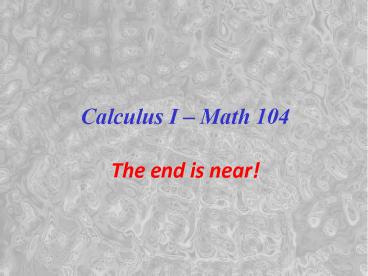Calculus I - PowerPoint PPT Presentation
Title:
Calculus I
Description:
Calculus I Math 104 The end is near! Series approximations for functions, integrals etc.. We've been associating series with functions and using them to evaluate ... – PowerPoint PPT presentation
Number of Views:186
Avg rating:3.0/5.0
Title: Calculus I
1
Calculus I Math 104The end is near!
2
Series approximations for functions, integrals
etc..
- We've been associating series with functions and
using them to evaluate limits, integrals and
such. - We have not thought too much about how good the
approximations are. For serious applications, it
is important to do that.
3
Questions you can ask--
- 1. If I use only the first three terms of the
series, how big is the error? - 2. How many terms do I need to get the error
smaller than 0.0001?
4
To get error estimates
- Use a generalization of the Mean Value Theorem
for derivatives
5
Derivative MVT approach
6
If you know...
- If you know that the absolute value of the
derivative is always less than M, then you know
that - f(x) - f(0) lt M x
- The derivative form of the error estimate for
series is a generalization of this.
7
Lagrange's form of the remainder
8
Lagrange...
- Lagrange's form of the remainder looks a lot like
what would be the next term of the series, except
the n1 st derivative is evaluated at an unknown
point between 0 and x, rather than at 0 - So if we know bounds on the n1st derivative of
f, we can bound the error in the approximation.
9
Example The series for sin(x) was
10
5th derivative
- For f(x) sin(x), the fifth derivative is f
'''''(x) cos(x). And we know that cos(t) lt 1
for all t between 0 and x. We can conclude from
this that - So for instance, we can conclude that the
approximation sin(1) 1 - 1/6 5/6 is accurate
to within 1/5! 1/120 -- i.e., to two decimal
places.
11
Your turn...
12
Another application...
- Another application of Lagrange's form of the
remainder is to prove that the series of a
function actually converges to the function. For
example, for the series for sin(x), we have
(since all the derivatives of sin(x) are always
less than or equal to 1 in absolute value)
13
Shifting the origin -- Taylor vs Maclaurin
- So far, we've been writing all of our series as
infinite polynomials and using values of the
function f(x) and its derivatives evaluated at
x0. It is possible to change one's point of view
and use values of the function and derivatives at
other points.
14
As an example, well return to the geometric
series
15
Taylor series
- By taking derivatives of the function g(x) -1/x
and evaluating them at x-1, we will discover
that the expansion of g(x) we have found is the
Taylor series for g(x) expanded around -1 - g(x) g(-1) g '(-1) (x1) g ''(-1)
....
16
Note
17
Maclaurin
- Series expansions around points other than zero
are useful when trying to approximate function
values for x far from zero, but close to a
different point where much is known about the
function. - But note that by defining a new function g(x)
f(xa), you can use Maclaurin expansions for g
instead of general Taylor expansions for f.
18
Binomial series
19
If p is not a positive integer...
20
Fibonacci numbers
Everyone is probably familiar with the famous
sequence of Fibonacci numbers. The idea is that
you start with 1 (pair of) rabbit(s) the zeroth
month. The first month you still have 1 pair. But
then in the second month you have 11 2 pairs,
the third you have 1 2 3 pairs, the fourth, 2
3 5 pairs, etc... The pattern is that if you
have a pairs in the nth month, and a
pairs in the n1st month, then you will have
pairs in the n2nd month. The
first several terms of the sequence are thus 1,
1, 2, 3, 5, 8, 13, 21, 34, 55, etc... Is there a
general formula for a ?
n1
n
a a
n1
n
n
21
Generating functions
- This is a common problem in many parts of
mathematics and science. And a powerful method
for solving such problems involves series --
which in this case are called generating
functions for their sequences. - For the Fibonacci numbers, we will simply define
a function f(x) via the series
22
Recurrence relation
- To do this, we'll use the fact that
multiplication by x "shifts" the series for f(x)
as follows - Now, subtract the second two from the first --
almost everything will cancel because of the
recurrence relation!
23
The result is...
24
Further...
25
Then use partial fractions to write
26
Work it out...
First
And
27
Now, recall that...
28
Our series for f(x) becomes































